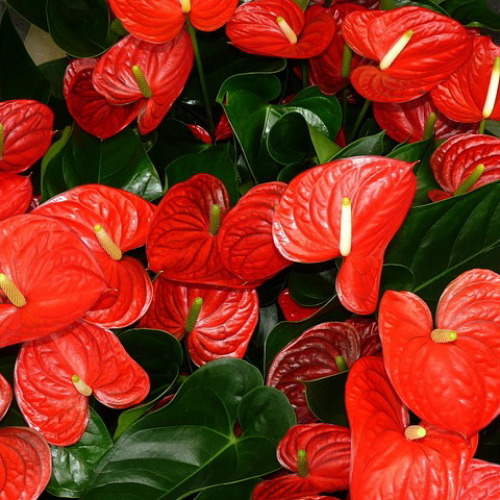Indoor plants Anthurium

Description
Characteristic Features of Anthurium
Anthurium has become extremely popular with plant enthusiasts because of its unique showy appearance. Despite the fact that the plant is quite expensive, everyone who knows it dreams of getting one for themselves.
Anthurium is a genus of evergreen plants in the arum family Araceae. It seems to be the most abundant one in the family, for it comprises almost 900 species. However, some sources only say about 500. There are climbing plants and trees, but mostly herbaceous plants (terrestrial, epiphytic, half epiphytic, and lithophytic) native to tropical rain forests, savannahs, rocky and/or stony areas. Some are noticed to be in symbiosis with ants.
In the wild, Anthurium is distributed from Mexico in Central America to Paraguay in South America.
It is even found in the Andes (Cordillera) thriving in the areas up to 3,400 metres above sea level.
Anthurium has thick and often short stems.
The leaves are greatly variable in shape and can be spatulate, cordate, lanceolate, multipinnate, entire or dissected. The plant can grow up to 118 centimetres tall (Anthurium acutissimum). The leaf surface is glossy, semi-glossy, or matte, leathery or brittle paper-like to the touch. In a humid tropical forest, the leaves can turn towards the sun like a sunflower does. In drier conditions, the clustered leaves form a rosette resembling a bird's nest. It accumulates organic debris that retains water and serves as natural fertilizer.
However, it is flowers that are the most exotic and beautiful part of Anthurium. The flowers are contained in dense spirals on the spadix. The spadix can be club-shaped, spring-shaped, cone-shaped, or globe-shaped. It can be white, green, red, pink, purple, or a combination of these colours. The perianth and the spathe are often very bright and attractive, red, purple, pink, or orange. Obviously, the beauty of the plant determines its relatively high cost, which discourages many plant enthusiasts. However, those who buy Anthurium, hardly ever regret having spent money on it. The plant is worth its cost, both in the winter and summer when it blooms.
The most common pot-type species is Anthurium scherzerianum. Anthurium crystallinum and Anthurium andraeanum have also gained vast popularity, but the latter is a hothouse species rather a houseplant because of its size. Interestingly, in its native Colombia, it is called the Flamingo Flower and in other Spanish-speaking countries, the Little Red Cape.
The Secrets to Successfully Growing Anthurium
Anthurium prefers bright filtered light and must be protected from direct sunlight.
In the summer, keep the soil moist but not soggy or waterlogged. In the winter, reduce watering but do not allow the soil to dry out.
High air humidity is preferable. Regularly mist the leaves or wipe them with a wet sponge. You can place the pot on a tray with damp moss. If you cover stems with moss, it will promote adventitious root growth.
Comfortable temperatures in the summer range from 20 to 28 ° C. In the winter, the temperature range is much narrower, 15-16 ° C. The temperature of 16-18 ° C in March and April will ensure profuse flowering. With a good care, the plant will bloom throughout the summer.
During the period of growth in the spring and summer, fertilize your plant every 15 days with organic fertilizer, alternating it with mineral fertilizer. Do not feed recently repotted plants.
Repot your Anthurium every spring. After the pot bottom reaches 25 centimetres across, report half as often. Plant in a mixture of leaf mold and small amounts of sand, humus, and loam. The soil should be loose and well-aerated.
Anthurium is propagated in different ways:
- By offshoots with roots,
- By tip and stem cuttings,
- By seeds. Sow the seeds at 25 ° C and they will germinate after a few months.
Pruning is not required.
Potential Problems
If the leaf tips turn black, it indicates high calcium contents in the soil. Remember to use soft water.
If the leaves shrivel, the reasons can be dry air, direct sunlight, low light, or drafts.
Spots on the leaves are caused by fungi.
Anthurium can get aphids, which are particularly fond of young shoots and blossoms. In the summer, apply anti-aphid solutions once a month for prevention. Anthurium is also susceptible to scale insects and thrips. The latter are particularly dangerous as they multiply very quickly and require much effort to be controlled.
While handling Anthuriums, do not forget that their sap is poisonous.







 5 350
5 350







